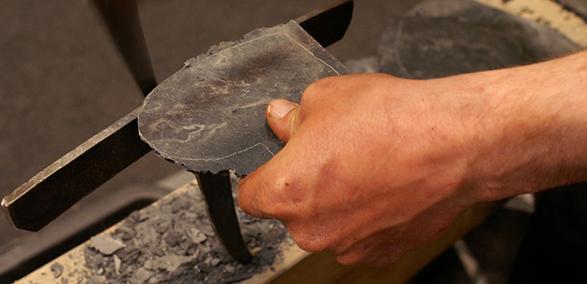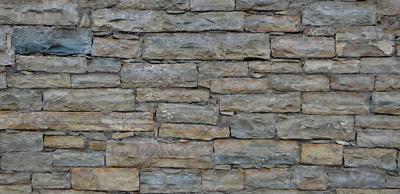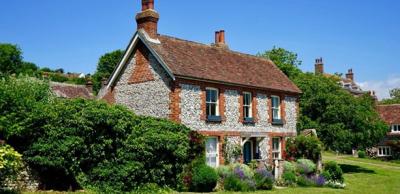“My dad told me about them!”: Slate building materials
Slate is a fine-grained metamorphic rock that’s been used since Roman times as a building material.
Because of its durability and attractive appearance, it’s popular for lots of uses, including roofing, wall cladding, and flooring.
Due to its structure, slate has a unique ability to be split along cleavage planes to create uniform sheets. This isn’t to be confused with sandstone and limestone slates that aren’t metamorphic and split along their bedding or fissile plane.
Originally the splitting was handcrafted but this is now done using laser for bulk production. Slate is particularly suitable as a roofing material as it has an extremely low water absorption index of less than 0.4%, making the material waterproof.
In fact, this natural slate, which needs only minimal processing, has the lowest embodied energy of all roofing materials. Slate is incredibly durable and can last several hundred years, often with little or no maintenance. Its low water absorption makes it very resistant to frost damage and breakage due to freezing.
Natural slate is also fire resistant and energy efficient.
The rise, fall... and rise of slate
In the UK, slate has been mined mainly in Wales, Cornwall and Cumbria for over 1,800 years.
Following the industrial revolution when road access to the remote mining areas became established, slate (particularly Welsh slate) was transported all over the world.
UK sales declined in the 20th century through recessions, world wars, foreign tax duties, cheaper competition and the emergence of the more fashionable concrete roof tiles. Although popularity is increasing again, 90% of European slate now comes from Spain.
|
Interested? |
 |
The technical details
Variations in thickness are an inherent property of natural slate and a principal cause of the texture and character. Slates are graded according to thickness within certain fairly wide tolerances from 'Bests' at around 4mm thick to 'Extra Heavies' at around 8.5mm. These thickness guides are based on British slate which is particularly strong and durable.
Imported slate often doesn’t have the same natural strength. Under the current European Standard EN 12326-1:2014 thickness is now calculated as a function of the bending strength required for its location.
The length of the slate is typically twice the width and sizes ranged from 12″ x 6″ up to 24″ x 14″ in imperial. The vast majority of roofs in this country that are pre-1980 will be covered with imperial sized slates so real care is needed if you’re trying to match European metric slates to an existing roof.
Roof tiles now need to achieve the designation A1S1T1 for new roofs, this means a water absorption of less than 0.6% (A1), carbonate content of less than 20% (S1) and a thermal cycle (mineral oxidation) of T1. This is essentially to make sure they won’t crack when frozen, won’t wear away with acid rain or discolour or develop rust stain patterning.
How slate is used
Fixing is typically with double nails onto timber battens in a double lap (England and Wales) or nailed directly onto timber sarking boards (Scotland and Northern Ireland). Nails were traditionally of copper, although there are modern alloy and stainless steel alternatives.
Both these methods, if used properly, provide a long-lasting weathertight roof with a lifespan of around 80–100 years.
Reroofing may sometimes only be necessary because the roof timbers need replacing rather than the slate which can then be reused.
Slate roofs are heavier than conventional roofs so the roof carcase needs to be substantial for the load and a specialist is required to install the roof properly using the correct tools. Other problems such as discolouration or whitening of the slates and excessive weathering has now been largely removed from the industry due to the European standard, but care is still needed on choice for refurbishment.
Slate is also very popular now as a decorative finish on internal walls, floors and kitchens surfaces.
Do you use these slate-related phrases?
The trade throws up some interesting terminology:
- A ‘slaters heel’ is a specialised form of scaffold used to work up the roof
- ‘Wrestlers’ are interlocked and notched roof tiles
- ‘Bachelors’ or ‘backers’ are narrow slates used over a wide slate to maintain coursing as slate numbers increase up the roof
- ‘Widebutts’ are the wide slate used with a backer
Found this interesting? Browse our "My dad told me about them" articles
Further information
Historic England's Stone Slate Roofing: Technical Advice Note
Glossary of Stone Slate Roofing
Please Note: Every care was taken to ensure the information was correct at the time of publication. Any written guidance provided does not replace the user’s professional judgement. It is the responsibility of the dutyholder or person carrying out the work to ensure compliance with relevant building regulations or applicable technical standards.
Sign up to the building bulletin newsletter
Over 48,000 construction professionals have already signed up for the LABC Building Bulletin.
Join them and receive useful tips, practical technical information and industry news by email once every 6 weeks.
Subscribe to the Building Bulletin




Comments
Fascinating article
Submitted 5 years 7 months ago
Add new comment